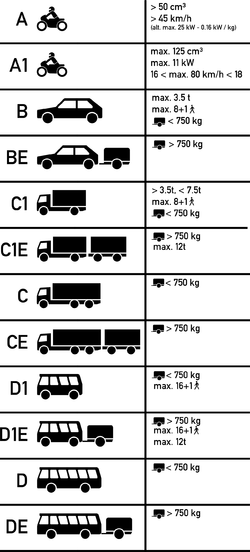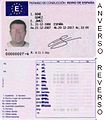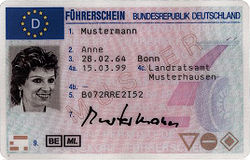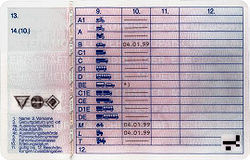- European driving licence
-
This article is about the European driving licence for vehicles. For the computer literacy certification, see European Computer Driving Licence.
The European driving licence is a driving licence replacing the many driving licence styles already in use in the member states of the European Union. It has the credit card-style with a photograph and possibly a microchip. They were introduced to replace the 110 different plastic and paper driving licences of the 300 million drivers in the EU. The main objective of the licence is to decrease the risk of fraud.
Contents
History
Pre-1996 European driving licence
The first step to a European driving licence was taken on 4 December 1980, when the Council of Ministers adopted Council Directive 80/1263/EEC on the introduction of a Community driving licence, which established a Community model national licence that guaranteed the mutual recognition by Member States of national licences. It also established the practice of exchange of licences by holders moving from one Member State to another.
European driving licence as from 1996
 European Union directive:
European Union directive:Directive 91/439/EEC Council Directive on driving licences Made by Council Made under Art. 75 TEC Journal reference History Made 1991-07-29 Came into force 1991-08-24 Implementation date 1996-07-01 Preparative texts Other legislation Replaces Directive 80/1263/EEC Status: Substantially amended On 29 July 1991, the Council of Ministers adopted the Council Directive 91/439/EEC on driving licences. The directive required Member States to adopt laws implementing the directive before 1 July 1994, which laws would take effect on 1 July 1996. Directive 80/1263/EEC would be repealed on the same date. Directive 91/439/EEC currently specifies the European driving licence.
Provisions
The directive harmonises the categories of driving licences among the Member States and establishes two Community driving licence models, one paper version and one plastic card version. It furthermore establishes an obligatory test of knowledge (theory) and a test of skills and behaviour (practical) which has to be successfully passed before an individual is offered a driving licence. It also requires an applicant to meet the minimum standards of physical and mental fitness to drive. The directive specifies the minimum ages for driving different types of vehicles, and establishes progressive access in categories A, C, and D, from light vehicles to larger or more powerful vehicles. The directive stipulates that it is mandatory to have the normal residence in the Member State issuing the licence.[1]
Amendments
The Directive has been substantially amended by nine directives and two acts of accession. The plastic card version of the Community licence model, for example, was added to the Directive by Council Directive 96/47/EC of 23 July 1996.[2]
New European driving licence as from 2013
 European Union directive:
European Union directive:Directive 2006/126/EC Directive of the European Parliament and of the Council on driving licences (Recast) Made by European Parliament & Council Made under Art. 71 TEC Journal reference History Made 2006-12-30 Came into force 2007-01-19 Implementation date 2013-01-19 Preparative texts Other legislation Replaces Directive 91/439/EEC Status: Current legislation In March 2006, the Council of Ministers adopted a Directive proposed by the European Commission to create a single European driving licence to replace the 110 different models currently in existence throughout the EU.[3][4] The European Parliament adopted the Directive in December 2006.[5] Directive 2006/126/EEC was published in the Official Journal of the European Union on 30 December 2006. Its provisions will take effect in 2013; Directive 91/439/EEC will then concurrently be repealed.
Provisions
The licence will be a credit-card-style, single plastic-coated document, very difficult to falsify. The document will be renewable every 10 or 15 years depending on the member state. The several member states will have the option to include a microchip containing information about the card holder on the card. This will prove extremely useful because police can access the driving licence in their own language. This would solve the problem with the three kinds of alphabet (Latin, Greek and Cyrillic) used in the EU. In addition, the fields of the driving licence are uniformly numbered, thus allowing the police to decipher the meaning of the fields without electronic access.
Some categories like C and D will be issued for five years only. After expiration, a medical check-up is necessary in order to renew the licence for another five years.
Implementation
The directive stipulates that members states should adopt laws implementing the directive no later than 19 January 2011. Those laws should take effect in all EU members states on 19 January 2013. All licences issued before that date will become invalid by 2033.
EEA relevance
The directive mentions that it has EEA relevance, meaning that its provisions in the end will also apply to Iceland, Norway, and Liechtenstein.
Categories valid in all EU countries[2]
Class Description Age of acquisition Assumes Includes Remarks Mopeds AM (M,H) Two-wheel vehicles or three-wheel vehicles with a maximum design speed of not more than 45 km/h and with a cylinder capacity not exceeding 50 cubic centimetres 16 years (15 years in Finland,Czech Republic, Slovenia, Spain and Sweden, 14 years in Estonia, Latvia, France, Italy, Portugal and Hungary). The category AM does not become EU-wide until 2013. — In Finland, Germany, Ireland and Norway, the class is called M. In Slovenia, the class is called H. Motorcycles A1 Motorcycles with a cylinder capacity not exceeding 125 cubic centimetres, of a power not exceeding 11 kW and with a power/weight ratio not exceeding 0,1 kW/kg and motor tricycles with a power not exceeding 15 kW. 16 years. Until 18 years just 80 km/h[citation needed]- except Norway, where there is no speed limit for A1[citation needed]. — M Recently, Portugal passed a law in which B and BE driving licencees can drive motorcycles not exceeding 125cc within Portugal. B licence holders in Latvia, Spain (Once you have a three years experience with B) and Italy are able to drive motorcycles not exceeding 125cc within the respective countries. A2 Motorcycles of a power not exceeding 25 kW and 0.16 kW/kg. 16 years (18 years in some countries) — A1, M A Motorcycles; motor tricycles with a power exceeding 25 kW. The minimum age for category A is fixed at 20 years (19 in the UK[6]). However, access to the driving of motorcycles of this category shall be subject to a minimum of two years' experience on motorcycles under an A2 licence, or in Ireland, 25kW or 0.16kW/kg [7] This requirement as to previous experience may be waived if the candidate is at least 24 years old (21 in UK with direct access). The minimum age for motor tricycles exceeding 15 kW is fixed at 21 years. A2 A1, M Motor vehicles B Motor vehicles with a maximum authorised mass not exceeding 3500 kg and designed and constructed for the carriage of no more than eight passengers in addition to the driver; motor vehicles in this category may be combined with a trailer having a maximum authorised mass which does not exceed 750 kg. 18 years (17 years in the UK, Iceland, Ireland and Hungary). — M, L, S Does not include S in Norway. BE Without prejudice to the provisions of type-approval rules for the vehicles concerned, combination of vehicles consisting of a tractor vehicle in category B and a trailer or semi-trailer where the maximum authorised mass of the trailer or semi-trailer does not exceed 3500 kg. 18 years (17 years in the UK, Germany and Ireland). B — Include T in Norway. Large goods vehicle C1 Large goods vehicle with a maximum authorised mass of not more than 7.5 t; with or without a trailer with a maximum mass of less than 750 kg. 18 years B — C1+E Combinations of vehicles where the tractor vehicle is in category C and its trailer or semi-trailer has a maximum authorised mass of over 750 kg. 21[citation needed] (18 in Sweden and Ireland; 18 in Germany (with limitation see class "C")) years C BE, C1E, D1E, DE[citation needed], T see C. C Large goods vehicle with a maximum authorised mass of more than 3.5 t mass and not more than 8 + 1 seats (lorry); with a trailer with a maximum mass of 750 kg. 21 years[citation needed] (18 years in Bulgaria, Sweden, Finland and Ireland; 18 years in Germany for non-commercial use only except for apprenticeship as professional driver) B C1 C+E Other combinations of vehicles and trailers which with combined maximum authorised mass of more than 750 kg. 18 years C1 BE, D1E or DE Buses D Vehicles with more than 8 + 1 seats (buses). 21 years[citation needed] B D1 Motor vehicles designed and constructed for the carriage of more than eight passengers in addition to the driver; motor vehicles which may be driven with a category D licence may be combined with a trailer having a maximum authorised mass which does not exceed 750 kg. D1 Light buses with a maximum of 16 + 1 seats. 21 years[citation needed] B — Motor vehicles designed and constructed for the carriage of no more than 16 passengers in addition to the driver.; motor vehicles in this category may be combined with a trailer having a maximum authorised mass not exceeding 750 kg. DE Combinations of vehicles where the tractor vehicle is in category D and its trailer has a maximum authorised mass of over 750 kg. 21 years[citation needed] D BE, D1E, C1E[citation needed] D1E Combinations of vehicles where the tractor vehicle is in category D1 and its trailer has a maximum authorised mass of over 750 kg. 21 years D1 BE, Includes articulated buses National categories
Furthermore there are more national categories for tractors, large motorcycles, motorised wheel boats, motor tricycles (modern voiturettes, Category B1 or S) and military categories such as for driving tanks.
BF17/L17 ("Begleitetes Fahren" - Accompanied driving) | At minor age, the driver must be accompanied by someone aged 30 and holding a valid B-license for a minimum of 5 years. Germany and Austria introduced this model a few years ago to decrease the accident rate among young drivers. BF17- (in Austria L17-) licenses are just approved in Germany and Austria. When the driver reaches legal age BF17/L17-licenses are transcribed to regular B-licenses.
Switzerland
Since the 2000s, Switzerland uses the EU system of vehicle categories, issues EU-style credit-card licences and has generally adopted much of the harmonised EU legislation with regard to drivers' licences.
To apply for a car driver's licence (category B), the applicant must be 18 years old. They must first attend first aid courses and pass have their view checked by an eye-doctor. Passing a theoretical exam is required to receive a learner's permit valid for two years. This allows them to drive a car only if accompanied by an adult 23 or older who has had his licence for at least 3 years. Before passing the practical exam, the candidate must attend 10 hours of theoretical lessons on "sensibilisation to road traffic". Practical driving lessons are not legally required, but are considered a de facto prerequisite for passing the practical exam with a government expert. Upon succeeding the practical exam a probationary driver's licence is issued for 3 years. To obtain the full, unlimited, driver's licence after these 3 years, the candidate must not commit a serious traffic infraction and attend 2 days of further driving training.
For motorcycles and heavier vehicles, the regulations are different, and some agrarian vehicles can be driven without a licence. As of 2011, a 45-minute driving lesson costs around 90 CHF, while the various fees and theoretical instruction costs associated with getting a car driver's licence can amount to up to CHF 600, without counting the costs for the two days of further training.
The theoretical exam must be taken in either German, French or Italian. In some cantons it is possible to take it in English.
Norway
While not a member of the European Union, Norway uses EU vehicle categories and issues EU-style credit-card licences, with the following deviations:
- In addition to the standard EU items, the bearer's national identification number is included as item 4d).
- Vehicle category A2 is not used.
- There are three additional vehicle categories: M for mopeds, S for snowmobiles and T for tractors.
Gallery
Sample licence
German version of a current EU driving licence - surname
- given name
- date of birth, place of birth
- a) date of issue b) date of expiry c) issuing authority
- licence number
- photograph of bearer
- signature of bearer
- ---
- licence categories
- first issuing date of the category
- expiry date of the category
- restrictions (number coded)
See also
- Driving Licence
- European Commissioner for Transport
- International driving licence
References
- ^ European Commission website - Transport: driving licence
- ^ a b Consolidated version of Directive 91/439/EEC as of 18 July 2008
- ^ "Klartecken för EU-körkort". Svenska Dagbladet. http://www.svd.se/dynamiskt/utrikes/did_12218466.asp. Retrieved 2006-03-27.
- ^ "EU backs European driving licence". BBC News. 27 March 2006. http://news.bbc.co.uk/1/hi/world/europe/4849330.stm. Retrieved 2 May 2010.
- ^ EU announces plans for European driving license
- ^ http://www.motorcycle.co.uk/articles/training/TheLaw.htm#Full
- ^ "S.I. 352 of 1999". Irish Statue book. http://www.irishstatutebook.ie/1999/en/si/0352.html.
External links
- http://www.workpermit.com/news/2006_12_18/eu/european_driving_license.htm
- http://ec.europa.eu/idabc/en/document/3826/330
- http://www.euractiv.com/en/transport/single-europe-wide-driving-licence-2013/article-160496
- http://news.bbc.co.uk/2/hi/europe/6180617.stm
- http://www.direct.gov.uk/en/Motoring/DriverLicensing/WhatCanYouDriveAndYourObligations/DG_4022547
Categories:- Driving licences
- Personal documents
- Traffic law
Wikimedia Foundation. 2010.








